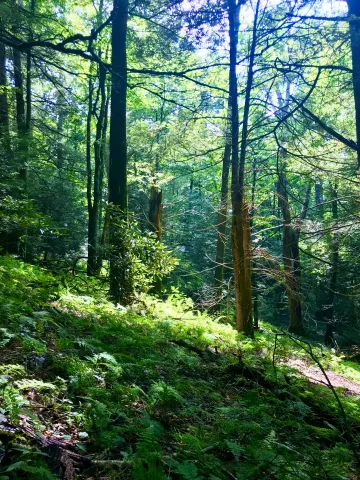Seeing the Forest for the Trees

By: Steve Roark
Volunteer Interpreter, Cumberland Gap National Historical Park
The dictionary defines a forest as "a tract of land covered with trees and underbrush." That's probably the way a lot of people think of the forest, but I submit to you that a forest is more than a bunch of trees.
A forest is a complex, dynamic system of plants and animals living in, on and above a suitable soil. Trees are indeed the dominant vegetation, but other green plants, such as shrubs, wildflowers, grasses, and vines, are important components of the forest. There are also non-green plants (fungi) that play a major role in the decomposition of dead plants and trees. Many animals are a part of a forest community, ranging from large deer to tiny insects and worms. Life forms in the forest interact with each other and form an interwoven web of dependence. In a word, an ecosystem.
The forest is made up of a series of levels, arranged from the tops of the trees down to the ground on which they grow. Each level creates a habitat where different species of plants and animals live. The upper level is called the canopy, formed by the crowns of the tallest trees. This is where photosynthesis, the miracle of turning water and air into food and building material, is carried out. The canopy is home to many thousands of insects, which in turn attract large numbers of bug eating birds. Squirrels are also active in the canopy for safety and food gathering.
Just below the canopy is the understory, made up of smaller trees pushing up toward the light. It has its own populations of animals, birds, and insects that find food and cover conditions here to their liking.
The next level down is the shrub layer, composed of many kinds of shrubs and vines, which offer still different nesting and feeding opportunities. This is the home of many of our songbirds that rely on the berries and seeds of shrubs for food, as well as protective cover.
Below the shrub layer is the herb layer, made up of plants with soft rather than woody stems. Here you will find wildflowers, grasses, ferns and mosses. Also living here are ground-nesting birds, mice, insects, snakes, and toads.
At the bottom is the forest floor where dead leaves, twigs, branches, and even whole trees accumulate and lie until they are turned into humus by the activity of fungi, millipedes, ants and such, all which are food opportunities for still more species of larger wildlife. So you see a forest is not just a stand of tall plants, but an amazing high rise apartment with tenants in the millions from top to bottom. A most interesting place to visit as often as you get a chance. Oh, and do bring the kids.
- Log in to post comments